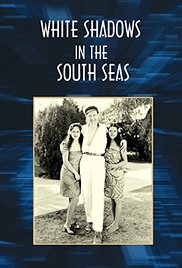
WHITE SHADOWS IN THE SOUTH SEAS
US, 1928, 88 minutes, Black and white and tints.
Monte Blue, Raquel Torres, Robert Anderson.
Under the supervision of W.S.Van Dyke and Robert Flaherty.
Robert Flaherty was a celebrated documentary filmmaker and had explored the Arctic in Nanook of the North and the Pacific in Moana. He collaborated here with prolific in MGM director, W.S. Van Dyke who had begun his career in 1917 in silent films and was to continue into the 1930s, directing all kind of genre films at MGM, dying in 1943. He also directed the MGM feature film set in the Arctic, Eskimo.
The film has a blend of silent footage and sound footage, filmed in black and white and many of the sequences tinted for release.
The company went on location into the Pacific, the islands of the Marquesas. The location photography is quite striking, highlighting the look of the islands, the presence of the indigenous people, some who had been influenced by white colonialism and others who had lived separated from the whites. There is quite some detail of the locals diving for pearls, their skills, the physical toll of the work, the exploitation by the white bosses.
The central character is an American doctor, Monte Blue, something of a derelict as he is called, living in the islands, becoming disillusioned, clashing with one of the pearl bosses, Sebastian, played by Robert Anderson. He is taken by the thugs and put on a boat, steered into shark waters, but the doctor gets control of the boat and lands on a remote island. He is welcome by the local people and finds himself at home. These lyrical sequences indicate the romantic attitudes towards South Sea people at the times.
All would have been well except for human nature… There is pearl diving at the remote island, the doctor becoming interested in the pearls, his greed overcoming some of his decency, his setting up a beacon to signal in case a ship should pass by. The ship that does come is under the command of Sebastian. There is a clash – resulting in the death of the doctor.
Very much a film of the 1920s in its characterisation and story, but an opportunity for some ethnographic study and observing of the Pacific islands in the 1920s.